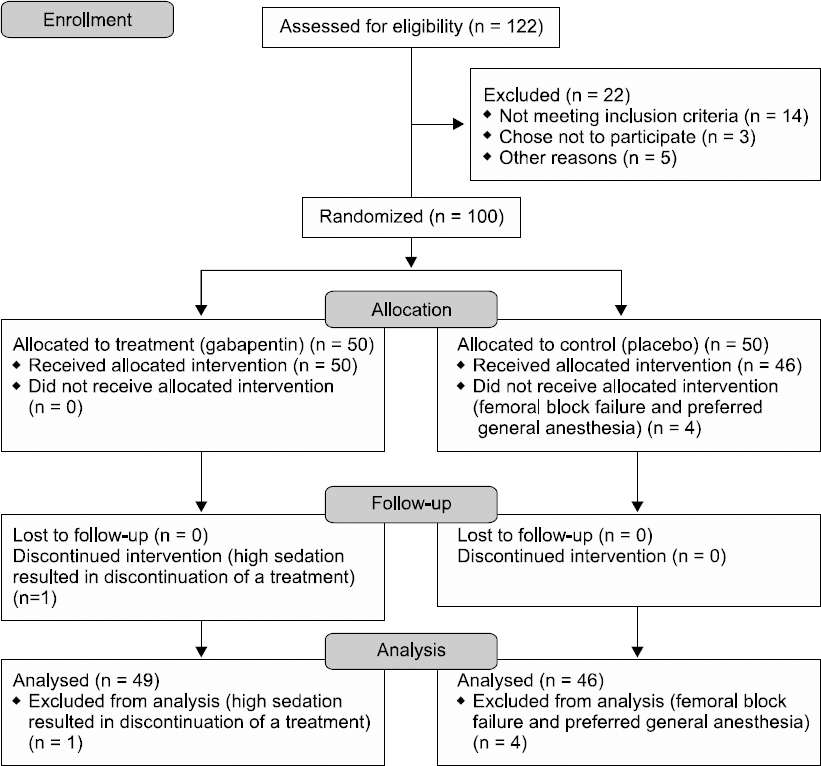1. Kehlet H, Jensen TS, Woolf CJ. Persistent postsurgical pain:risk factors and prevention. Lancet. 2006; 367:1618–25. DOI:
10.1016/S0140-6736(06)68700-X.
2. Pinto PR, McIntyre T, Ferrero R, Araújo-Soares V, Almeida A. Persistent pain after total knee or hip arthroplasty:differential study of prevalence, nature, and impact. J Pain Res. 2013; 6:691–703. DOI:
10.2147/JPR.S45827. PMID:
24072977. PMCID:
PMC3783511.
3. Kehlet H, Dahl JB. The value of “multimodal” or “balanced analgesia” in postoperative pain treatment. Anesth Analg. 1993; 77:1048–56. DOI:
10.1213/00000539-199311000-00030.
4. Rowbotham M, Harden N, Stacey B, Bernstein P, Magnus-Miller L. Gabapentin for the treatment of postherpetic neuralgia:a randomized controlled trial. JAMA. 1998; 280:1837–42. DOI:
10.1001/jama.280.21.1837. PMID:
9846778.
5. Serpell MG. Gabapentin in neuropathic pain syndromes:a randomised, double-blind, placebo-controlled trial. Pain. 2002; 99:557–66. DOI:
10.1016/S0304-3959(02)00255-5.
6. Mathiesen O, Møiniche S, Dahl JB. Gabapentin and postoperative pain:a qualitative and quantitative systematic review, with focus on procedure. BMC Anesthesiol. 2007; 7:6. DOI:
10.1186/1471-2253-7-6. PMID:
17617920. PMCID:
PMC1950698.
7. Clarke H, Pereira S, Kennedy D, Gilron I, Katz J, Gollish J, et al. Gabapentin decreases morphine consumption and improves functional recovery following total knee arthroplasty. Pain Res Manag. 2009; 14:217–22. DOI:
10.1155/2009/930609. PMID:
19547761. PMCID:
PMC2706552.
8. Peng PW, Wijeysundera DN, Li CC. Use of gabapentin for perioperative pain control -- a meta-analysis. Pain Res Manag. 2007; 12:85–92. DOI:
10.1155/2007/840572. PMID:
17505569. PMCID:
PMC2670715.
9. Kim JH, Seo MY, Hong SD, Lee J, Chung SK, Kim HY, et al. The efficacy of preemptive analgesia with pregabalin in septoplasty. Clin Exp Otorhinolaryngol. 2014; 7:102–5. DOI:
10.3342/ceo.2014.7.2.102. PMID:
24917905. PMCID:
PMC4050080.
10. Ménigaux C, Adam F, Guignard B, Sessler DI, Chauvin M. Preoperative gabapentin decreases anxiety and improves early functional recovery from knee surgery. Anesth Analg. 2005; 100:1394–9. DOI:
10.1213/01.ANE.0000152010.74739.B8. PMID:
15845693. PMCID:
PMC1351382.
11. Ho KY, Gan TJ, Habib AS. Gabapentin and postoperative pain--a systematic review of randomized controlled trials. Pain. 2006; 126:91–101. DOI:
10.1016/j.pain.2006.06.018. PMID:
16846695.
12. Lunn TH, Husted H, Laursen MB, Hansen LT, Kehlet H. Analgesic and sedative effects of perioperative gabapentin in total knee arthroplasty:a randomized, double-blind, placebo-controlled dose-finding study. Pain. 2015; 156:2438–48. DOI:
10.1097/j.pain.0000000000000309. PMID:
26230741.
13. Sutton KG, Martin DJ, Pinnock RD, Lee K, Scott RH. Gabapentin inhibits high-threshold calcium channel currents in cultured rat dorsal root ganglion neurones. Br J Pharmacol. 2002; 135:257–65. DOI:
10.1038/sj.bjp.0704439. PMID:
11786502. PMCID:
PMC1573104.
15. Al-Mujadi H, A-Refai AR, Katzarov MG, Dehrab NA, Batra YK, Al-Qattan AR. Preemptive gabapentin reduces postoperative pain and opioid demand following thyroid surgery. Can J Anaesth. 2006; 53:268–73. DOI:
10.1007/BF03022214. PMID:
16527792.
16. Frouzanfard F, Fazel MR, Abolhasani A, Fakharian E, Mousavi G, Moravveji A. Effects of gabapentin on pain and opioid consumption after abdominal hysterectomy. Pain Res Manag. 2013; 18:94–6. DOI:
10.1155/2013/787401. PMID:
23662292. PMCID:
PMC3718059.
17. Doleman B, Heinink TP, Read DJ, Faleiro RJ, Lund JN, Williams JP. A systematic review and meta-regression analysis of prophylactic gabapentin for postoperative pain. Anaesthesia. 2015; 70:1186–204. DOI:
10.1111/anae.13179. PMID:
26300519.
18. Buvanendran A, Kroin JS, Della Valle CJ, Kari M, Moric M, Tuman KJ. Perioperative oral pregabalin reduces chronic pain after total knee arthroplasty:a prospective, randomized, controlled trial. Anesth Analg. 2010; 110:199–207. DOI:
10.1213/ANE.0b013e3181c4273a. PMID:
19910619.
19. Turan A, Kaya G, Karamanlioglu B, Pamukçu Z, Apfel CC. Effect of oral gabapentin on postoperative epidural analgesia. Br J Anaesth. 2006; 96:242–6. DOI:
10.1093/bja/aei294. PMID:
16361302.
20. Carmichael NM, Katz J, Clarke H, Kennedy D, Kreder HJ, Gollish J, et al. An intensive perioperative regimen of pregabalin and celecoxib reduces pain and improves physical function scores six weeks after total hip arthroplasty:a prospective randomized controlled trial. Pain Res Manag. 2013; 18:127–32. DOI:
10.1155/2013/258714. PMID:
23748252. PMCID:
PMC3673929.
21. Clarke HA, Katz J, McCartney CJ, Stratford P, Kennedy D, Pagé MG, et al. Perioperative gabapentin reduces 24 h opioid consumption and improves in-hospital rehabilitation but not post-discharge outcomes after total knee arthroplasty with peripheral nerve block. Br J Anaesth. 2014; 113:855–64. DOI:
10.1093/bja/aeu202. PMID:
24980426.
22. Moore A, Costello J, Wieczorek P, Shah V, Taddio A, Carvalho JC. Gabapentin improves postcesarean delivery pain management:a randomized, placebo-controlled trial. Anesth Analg. 2011; 112:167–73. DOI:
10.1213/ANE.0b013e3181fdf5ee. PMID:
21081764.
23. Rimaz S, Alavi CE, Sedighinejad A, Tolouie M, Kavoosi S, Koochakinejad L. Effect of gabapentin on morphine consumption and pain after surgical debridement of burn wounds:a double-blind randomized clinical trial study. Arch Trauma Res. 2012; 1:38–43. DOI:
10.5812/atr.5397. PMID:
24719841. PMCID:
PMC3955940.
24. Pandey CK, Sahay S, Gupta D, Ambesh SP, Singh RB, Raza M, et al. Preemptive gabapentin decreases postoperative pain after lumbar discoidectomy. Can J Anaesth. 2004; 51:986–9. DOI:
10.1007/BF03018484. PMID:
15574547.
25. Turan A, Karamanlioğlu B, Memiş D, Hamamcioglu MK, Tükenmez B, Pamukçu Z, et al. Analgesic effects of gabapentin after spinal surgery. Anesthesiology. 2004; 100:935–8. DOI:
10.1097/00000542-200404000-00025. PMID:
15087630.
26. Fassoulaki A, Melemeni A, Paraskeva A, Petropoulos G. Gabapentin attenuates the pressor response to direct laryngoscopy and tracheal intubation. Br J Anaesth. 2006; 96:769–73. DOI:
10.1093/bja/ael076. PMID:
16595614.
27. Narai Y, Imamachi N, Saito Y. Gabapentin augments the antihyperalgesic effects of diclofenac sodium through spinal action in a rat postoperative pain model. Anesth Analg. 2012; 115:189–93. DOI:
10.1213/ANE.0b013e31824e5da3. PMID:
22467888.
28. Eckhardt K, Ammon S, Hofmann U, Riebe A, Gugeler N, Mikus G. Gabapentin enhances the analgesic effect of morphine in healthy volunteers. Anesth Analg. 2000; 91:185–91. DOI:
10.1213/00000539-200007000-00035. PMID:
10866910.
29. Pandey CK, Navkar DV, Giri PJ, Raza M, Behari S, Singh RB, et al. Evaluation of the optimal preemptive dose of gabapentin for postoperative pain relief after lumbar diskectomy:a randomized, double-blind, placebo-controlled study. J Neurosurg Anesthesiol. 2005; 17:65–8. DOI:
10.1097/01.ana.0000151407.62650.51. PMID:
15840990.
30. Chang CY, Challa CK, Shah J, Eloy JD. Gabapentin in acute postoperative pain management. Biomed Res Int. 2014; 2014:631756. DOI:
10.1155/2014/631756. PMID:
24829909. PMCID:
PMC4009126.




 PDF
PDF Citation
Citation Print
Print



 XML Download
XML Download